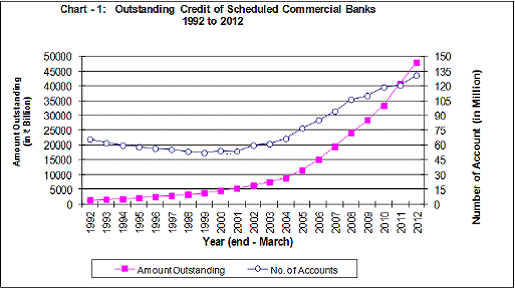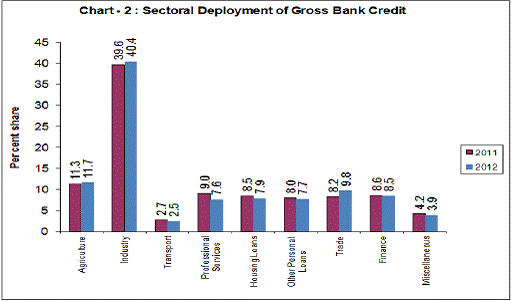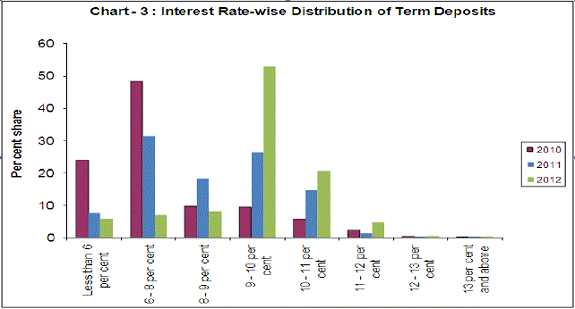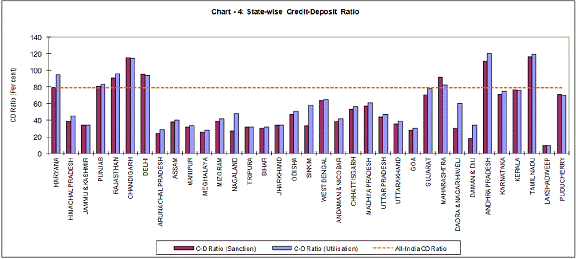1. The publication ‘Basic Statistical Returns of Scheduled Commercial Banks in India -Volume 41’ is based on data collected through BSR 1 and 2 surveys as on March 31, 2012, which covered 1,00,805 offices of scheduled commercial banks including regional rural banks. The salient findings of the surveys are set out below:
Outstanding Credit of Scheduled Commercial Banks:-
2. Growth of gross outstanding credit:
-
At the end of March 2012 gross outstanding credit of scheduled commercial banks amounted to ` 48,032,669 million registering an increase of 17.9 per cent as against an increase of 21.8 per cent in the previous year (Table No.1.3).
- The number of borrowal accounts increased by 8.4 per cent to 131 million in 20121 from 121 million in 2011 (Table No. 1.3).
3. Population group-wise distribution of credit:
-
Rural centers registered the highest growth in gross bank credit at 28.6 per cent in 2012 as compared to 18.7 per cent last year. The credit growth in Semi-urban centers increased to 20.5 per cent from 19.3 percent in 2011. Urban and Metropolitan centers registered credit growth of 14.3 and 17.2 per cent respectively, which are lower than last year’s growth of 22.4 per cent each. (Table No. 1.3).
-
The growth in gross bank credit extended by rural branches in 2012 was influenced by shifting of some large credit accounts for food procurement from Metropolitan to Rural branches. The growth in bank credit in Rural centers, excluding food procurement credit was at 22.1 per cent (Table No. 1.3). The credit growth, excluding food procurement credit, for Semi-urban, Urban and Metropolitan centers were at 21.0, 15.4 and 17.3 per cent respectively.
-
The shares of Urban and Metropolitan centers in the incremental credit in2 2011-12, excluding food procurement credit, were lower at 14.7 and 65.5 per cent respectively as compared to 17.4 and 68.3 per cent respectively in the previous year. The shares of Rural and Semi-urban centers, on the other hand, increased to 8.7 and 11.2 per cent respectively from 6.0 and 8.3 per cent respectively in 2010-11 indicating higher credit offtake in Rural and Semi-urban centers in 2011-12.
4. Bank group-wise distribution of credit:
-
The share of the Nationalized Banks in total bank credit marginally decreased to 52.4 per cent in 2012 from 53.0 per cent in 2011. Share of Private Sector Banks increased to 18.5 per cent in 2012 as compared to 17.8 per cent in 2011. The share of other bank groups remained almost unchanged (Table No.1.4).
-
The Private Sector Banks registered the highest credit growth at 22.1 per cent followed by Foreign Banks (19.6 per cent), Regional Rural Banks (18.6 per cent), SBI & Associates (17.3 per cent) and Nationalized Banks (16.5 per cent). Credit growth of all the bank groups (except SBI & Associates and Regional Rural Banks) declined in 2012 as compared to 2011.
-
Of the incremental credit in 2011-12, the share of Nationalized Banks declined to 48.8 per cent as compared to 57.8 per cent in 2010-11. The shares of other bank groups viz., Private Sector Banks (22.1 per cent), SBI & Associates (21.2 per cent), Foreign Banks (5.4 per cent) and Regional Rural Banks (2.5 per cent) in the incremental credit were higher than their respective shares in 2010-11.
5. Sectoral (occupation-wise) deployment of bank credit:
-
The shares of credit to Agriculture and Industrial sectors in gross bank credit increased marginally to 11.7 and 40.4 per cent respectively from 11.3 and 39.6 per cent respectively in 2011 (Table 1.11 and Chart 2).
-
The shares of ‘Housing loans’ and ‘Other Personal loans’ reduced to 7.9 and 7.7 per cent respectively from 8.5 and 8.0 per cent respectively in 2011. The share of ‘Professional & Other Services’ also reduced to 7.6 per cent from 9.0 per cent in 2011.
-
The share of credit to Trade sector increased to 9.8 per cent in 2012 from 8.2 per cent in 2011.
6. Sectoral (Occupation-wise) credit growth:
-
The growth rate of bank credit to Agriculture sector and Industrial sector increased to 21.9 and 20.5 per cent, respectively in 2012 as compared to 18.1 and 18.9 per cent respectively in 2011 (Table 1.9).
-
Credit to Trade sector registered growth rate of 40.6 per cent which is significantly higher than previous year’s credit growth for this sector (9.1 per cent).
-
All other sectors witnessed lower credit growth in 2012 as compared to the previous year. Credit to ‘Transport operators’ registered 6.8 per cent growth (28.7 per cent in 2011). ‘Housing Loans’ and ‘Other Personal loans’ grew at 9.5 and 14.6 per cent respectively in 2012 as compared to 12.9 and 28.4 per cent respectively in 2011. Growth in credit to Financial sector decreased to 16.5 per cent in 2012 as compared to 44.3 per cent in the previous year. Credit to ‘Professional and Other Services’ sector witnessed a small decline in 2012 as against a growth of 20.5 per cent in 2011.
7. Sectoral (Occupation-wise) share in incremental bank credit:
-
Shares of Agricultural sector and Industrial sector in the incremental credit increased to 13.9 and 45.3 per cent respectively in 2011-12 as compared to 9.7 and 35.2 per cent respectively in 2010-11.
-
The Trade sector absorbed about 18.6 per cent of the incremental credit in 2011-12 as compared to 3.8 per cent in 2010-11.
-
The share of all other sectors in incremental credit declined in 2011-12 as compared to 2010-11. The shares of ‘Housing loans’ and ‘Other Personal loans’ reduced to 4.5 and 6.5 per cent respectively from 5.4 and 9.8 per cent respectively in 2010-11. Shares of credit to ‘Transport Operators’ and Financial Sector reduced to 1.0 and 8.0 per cent respectively in 2011-12 as compared to 3.4 and 14.7 per cent in 2010-11.
8. Size-wise distribution of bank credit:
-
The number of small borrowal accounts (with credit limit up to ` 0.2 million) contributed 83.4 per cent of the total number of borrowal accounts as against 84.6 per cent in 2011, while the share of outstanding credit of small borrowal accounts was 9.5 per cent as compared to 9.4 per cent in 2011 (Table No.1.12).
-
Accounts with credit limit above ` 250 million each, had a share of 48.4 per cent of the total outstanding credit in 2012 as compared to 47.3 per cent in the previous year.
9. Interest rate on bank credit:
-
The distribution of outstanding credit according to interest rate ranges (available for each account with credit limit of over ` 0.2 million) revealed a shift towards higher rates in 2012. For the interest rate range ‘less than 10.0 per cent’, the proportion of credit reduced to 10.5 per cent from 27.9 per cent in the previous year. On the other hand, the proportion of credit with interest rate ‘14.0 per cent and above’, increased to 30.3 per cent from 15.1 per cent and for the interest rate range ‘10.0 per cent and above but below 14.0 per cent’, the proportion increased to 59.3 per cent from 57 per cent in the previous year (Table No. 1.13).
-
The weighted average interest rate in respect of all loans and advances with credit limit of over ` 0.2 million worked out to be 12.57 per cent as at the end of March 2012 as compared to 11.44 per cent a year ago.
Aggregate Deposits:-
10. Growth in aggregate deposits:
-
Aggregate deposits amounted to ` 60,782,433 million, registering a growth of 12.8 per cent in 2012 as against 18.2 per cent in previous year (Table No.1.18). The Savings deposit grew at a much lower rate of 9.5 per cent as compared to 19.2 per cent previous year. Also, the Current deposit registered a decline of 2.7 per cent as compared to the growth of 20.7 per cent in 2011. Growth in Term deposit increased marginally to 17.4 per cent from 17.2 per cent in 2011.
-
The number of deposit accounts in 2012 increased by 11.4 per cent to 903 million from about 810 million in 2011. Total number of savings bank account in 2012 was 703 million as compared to 624 million in 2011.
11. Bank group-wise distribution of deposits:
-
The share of Nationalized Banks in aggregate bank deposits reduced to 52.8 per cent in 2012 from 53.2 per cent in 2011. The share of SBI and Associates increased marginally to 21.7 per cent in 2012 from 21.4 per cent in 2011 (Table No.1.4).
-
The deposits of the Nationalized Banks registered a growth of 12.0 per cent which is lower than the previous year’s growth of 21.1 per cent. Similarly the deposits of Regional Rural Banks and Private Sector Banks registered lower growth rates of 10.9 and 12.9 per cent respectively, (15.3 and 20.5 per cent respectively in 2011). SBI and Associates registered higher deposit growth at 14.4 per cent (13.3 per cent in 2011). Also Foreign Bank’s deposits grew at 15.3 per cent which is higher than previous year’s growth figure of 2.9 per cent.
12. Type of deposits:
- The share of term deposits in total deposits increased to 62.8 per cent in 2012 from 60.4 per cent in 2011. The shares of current deposits and saving deposits declined to 10.7 and 26.4 per cent, respectively in 2012 from 12.4 and 27.2 per cent in 2011 (Table No.1.18).
13. Maturity pattern of term deposits:
-
The share of term deposits with original maturity period of 5 years and above in total term deposits increased to 9.3 per cent in 2012 from 8.8 per cent in 2011. Also, deposits with maturity ‘1 year to less than 2 years’ witnessed increase in the share to 45.7 per cent (from 40.8 per cent in 2011). (Table No.1.24)
-
Deposits with maturity period ‘2 years to less than 3 years’ and ‘3 years to less than 5 years’ witnessed decrease in their shares to 9.4 per cent (from 12.8 per cent in 2011) and 9.9 per cent (from 11.0 per cent in 2011) respectively.
-
The above change in maturity pattern is in tandem with the deposit interest rate structure of banks prevailed in 2011-12.
14. Interest rate on term deposits:
-
The weighted average interest rate of term deposits worked out to 9.19 per cent in 2012, as compared to 8.29 per cent in 2011 (Table No.1.28).
-
A shift in the distribution of term deposits towards the higher interest rates is observed. The share of term deposits with interest rate less than 9.0 per cent in total term deposits decreased to 21.1 per cent in 2012 from 57.3 per cent in the previous year. Also the share of deposits with interest rate ‘9.0 per cent and above’ increased to 78.9 per cent (as compared to 42.8 per cent in 2011) with highest share of 53.0 per cent in the interest rate range 9.0-10.0 per cent. (Table No.1.28 and Chart 3).
Credit - Deposit Ratio:-
(As per Place of Sanction and Place of Utilisation of Credit)
15. Population group-wise C-D Ratio:
-
The All-India C-D ratio was at 79.0 per cent in 2012 compared to 75.6 per cent in 2011.
-
As per place of sanction of credit, the C-D ratio in respect of Rural centers at the end of March 2012 was at 66.4 per cent as compared to 60.0 per cent in the previous year. In the case of Semi-urban, Urban and Metropolitan centers, the C-D ratios (as per place of sanction) were 54.6, 61.4 and 93.8 per cent respectively compared to 53.2, 61.6 and 88.4 per cent in the previous year.
-
The C-D ratios as per place of utilization of credit for Rural, Semi-urban, Urban and Metropolitan centers were 77.1, 62.7, 67.2 and 87.8 per cent, respectively, compared to 79.6, 63.1, 70.2 and 79.9 per cent, respectively in the previous year. (Table No.1.6).
16. Bank group-wise C-D Ratio:
-
The C-D ratio of SBI & Associates was at 79.3 per cent in 2012 compared to 77.3 per cent in the previous year while C-D ratio of Nationalized Banks was at 78.4 per cent (compared to 75.4 per cent in 2011).
-
The C-D ratios of Foreign Banks (88.1 per cent), Regional Rural Banks (64.1 per cent) and Private Sector Banks (80.8 per cent) have increased in 2012 from their levels in the previous year (85.0, 59.9 and 74.7 per cent respectively).
17. Migration of credit among the states:
-
An analysis of migration of credit among the states has been done through the Credit-Deposit ratio, calculated as per the place of sanction and place of utilization of credit. It is observed that Haryana, Sikkim, Nagaland, Dadra & Nagar Haveli and Daman & Diu had significantly higher C-D ratio as per place of utilisation than place of sanction. (Table No. 1.7 and Chart –4)
-
Haryana, Punjab, Rajasthan, Chandigarh, Delhi, Maharashtra, Andhra Pradesh and Tamil Nadu had higher C-D ratios as compared to all India C-D ratio of 79 per cent.
-
Chandigarh, Andhra Pradesh and Tamil Nadu registered C-D ratio more than 100 per cent.
|
 IST,
IST,





















